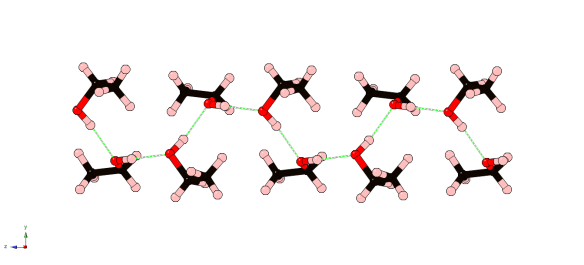Happy New Year Hangover – Ethanol
What does it look like?

Image generated with Crystal Maker software http://www.crystalmaker.com/
What is it?
With the new year still fresh, this is a molecule that many people will be staying well away from – it’s ethanol, a.k.a. drinking alcohol. Whilst most people are familiar with this molecule in its diluted liquid form, it can be solidified in a crystalline form at a chilly -114 °C. Whilst used for libations throughout much of human history, its largest use is as fuel, due to its clean combustion and availability from agricultural sources, as well as being an important chemical solvent and feedstock.
The crystal structure of ethanol highlights its similarity to ice – (CH3CH2)OH vs. HOH. The structure of ethanol contains hydrogen bonding (non-bonding electrostatic interactions) between hydrogen and oxygen atoms, shown in green in the picture. The molecules arrange themselves into chains through these non-bonding contacts, in contrast to the higher dimensionality structures of ice which contains more oxygen-bound hydrogen atoms and therefore more hydrogen bonds. This partially accounts for the 114 degree difference in their freezing points.
Where did the structure come from?
This structure was reported in 1976 by Jönsson. The diffraction data was collected at -186 °C. Whilst this sounds extreme, such experimental temperatures are nowadays routine and are typically accessed by blowing a cold gas stream over the sample, generated using liquid nitrogen. The structure is #5910115 in the Crystallography Open Database.






